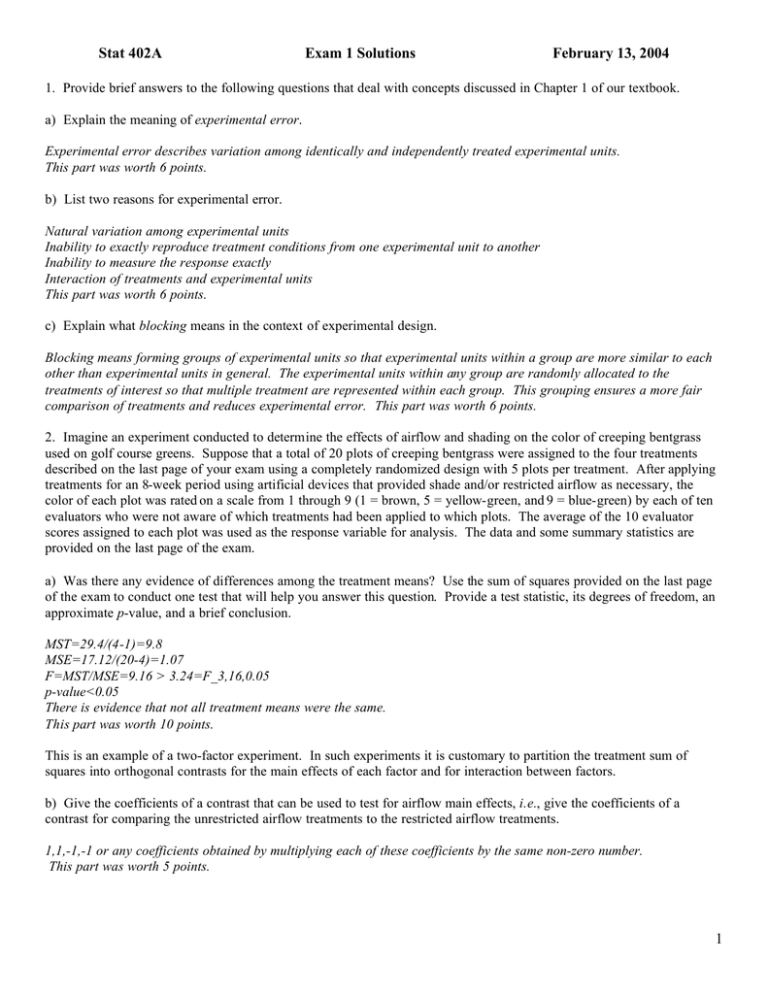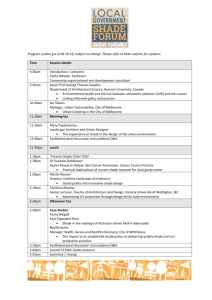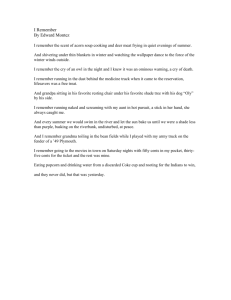Document 10639536
advertisement

Stat 402A Exam 1 Solutions February 13, 2004 1. Provide brief answers to the following questions that deal with concepts discussed in Chapter 1 of our textbook. a) Explain the meaning of experimental error. Experimental error describes variation among identically and independently treated experimental units. This part was worth 6 points. b) List two reasons for experimental error. Natural variation among experimental units Inability to exactly reproduce treatment conditions from one experimental unit to another Inability to measure the response exactly Interaction of treatments and experimental units This part was worth 6 points. c) Explain what blocking means in the context of experimental design. Blocking means forming groups of experimental units so that experimental units within a group are more similar to each other than experimental units in general. The experimental units within any group are randomly allocated to the treatments of interest so that multiple treatment are represented within each group. This grouping ensures a more fair comparison of treatments and reduces experimental error. This part was worth 6 points. 2. Imagine an experiment conducted to determine the effects of airflow and shading on the color of creeping bentgrass used on golf course greens. Suppose that a total of 20 plots of creeping bentgrass were assigned to the four treatments described on the last page of your exam using a completely randomized design with 5 plots per treatment. After applying treatments for an 8-week period using artificial devices that provided shade and/or restricted airflow as necessary, the color of each plot was rated on a scale from 1 through 9 (1 = brown, 5 = yellow-green, and 9 = blue-green) by each of ten evaluators who were not aware of which treatments had been applied to which plots. The average of the 10 evaluator scores assigned to each plot was used as the response variable for analysis. The data and some summary statistics are provided on the last page of the exam. a) Was there any evidence of differences among the treatment means? Use the sum of squares provided on the last page of the exam to conduct one test that will help you answer this question. Provide a test statistic, its degrees of freedom, an approximate p-value, and a brief conclusion. MST=29.4/(4-1)=9.8 MSE=17.12/(20-4)=1.07 F=MST/MSE=9.16 > 3.24=F_3,16,0.05 p-value<0.05 There is evidence that not all treatment means were the same. This part was worth 10 points. This is an example of a two-factor experiment. In such experiments it is customary to partition the treatment sum of squares into orthogonal contrasts for the main effects of each factor and for interaction between factors. b) Give the coefficients of a contrast that can be used to test for airflow main effects, i.e., give the coefficients of a contrast for comparing the unrestricted airflow treatments to the restricted airflow treatments. 1,1,-1,-1 or any coefficients obtained by multiplying each of these coefficients by the same non-zero number. This part was worth 5 points. 1 c) Give the coefficients of a contrast that can be used to test for shade main effects, i.e., give the coefficients of a contrast for comparing the shade treatments to the no shade treatments. -1,1,-1,1 or any coefficients obtained by multiplying each of these coefficients by the same non-zero number. This part was worth 5 points. 2. d) Give the coefficients of a contrast that is orthogonal to each of the contrasts in parts (b) and (c). This contrast can be used to test for interaction between the airflow and shading factors. This contrast for interaction compares the difference between shade and no shade treatments when airflow is unrestricted to the difference between shade and no shade treatments when airflow is restricted. -1,1,1,-1 or any coefficients obtained by multiplying each of these coefficients by the same non-zero number. This part was worth 5 points. Many students gave two separate contrasts, one orthogonal to the contrast in part (b) and one orthogonal to the contrast in part (c). The problem asks for one contrast that is orthogonal to both of the contrasts in parts (b) and (c). I tried to make this clear in the statement of the problem by asking for "a contrast" and discussing "this contrast." Furthermore the intro in front of part (b) mentioned that we were partitioning the treatment sum of squares into a set of orthogonal contrasts. Since this sum of squares has only 3 d.f., there can be only three contrasts total. The statement of the problem also tries to spell out how to form the interaction contrast: compare the difference between shade and no shade treatments when airflow is unrestricted to the difference between shade and no shade treatments when airflow is restricted. The difference between the shade and no shade treatments when airflow is unrestricted is µ2-µ1. The difference between the shade and no shade treatments when airflow is restricted is µ4-µ3. To compare those differences we need to check to see if the difference between the differences is zero. That difference is (µ2-µ1)-(µ4-µ3)= -µ1+µ2+µ3-µ4 which leads to the coefficients -1,1,1,-1. e) Fill in the blanks in the following table. This table is intended to provide a more detailed breakdown of the "treatment" line in the standard ANOVA table. The contrasts described in the table match the contrasts defined in parts (b) through (d) above. To save time, you are not required to write a conclusion for each of these tests; just fill in the blanks. DF Sum of Squares Mean Square F p-value unrestricted vs. restricted airflow 1 5.0 5.0 4.67 <0.05 shade vs. no shade 1 24.2 24.2 22.6 <0.05 interaction 1 0.2 0.2 0.19 >0.05 Contrast The contrast sum of squares for unrestricted vs. restricted airflow is computed as follows. [(1)8+(1)6+(-1)7.2+(-1)4.8]^2 = 4 = 5 [(1)^2+(1)^2+(-1)^2+(-1)^2]/5 (4/5) The contrast sum of squares for shade vs. no shade is computed as follows. [(-1)8+(1)6+(-1)7.2+(1)4.8]^2 = 19.36 = 24.2 [(-1)^2+(1)^2+(-1)^2+(1)^2]/5 (4/5) The contrast sum of squares for interaction can be computed in the same manner as the other two, or to save time, the contrast sum of squares must be the treatment sum of squares minus (5+24.2), i.e., 29.4-(5+24.2)=0.2 because the three contrast sums of squares must add to the treatment sum of squares due to orthogonality. This part was worth 15 points. Note that you could still complete this whole table even if you could not determine the coefficients for the interaction contrast in part (d). 2 3. A researcher is interested in studying the effects of long-term storage temperature on meat quality. The researcher randomly assigns 30 pork chops to 6 freezers so that each freezer contains 5 pork chops. The researcher then randomly assigns the temperatures -30, -25, and -20 degrees Celsius to the 6 freezers in a completely randomized manner so that two freezers are kept at each temperature throughout the experiment. After storage for 6 months, a meat quality score is assigned to each of the 30 pork chops. Circle the best answer in each part below. a) An experimental unit in this experiment is: a group of 5 pork chops stored together in a freezer The treatments (temperatures) were assigned to freezers and, more precisely, to the groups of 5 pork chops stored together in freezers. This part was worth 6 points. b) An observational unit in this experiment is: a single pork chop Measures of the response were obtained for each pork chop. Thus pork chops are the observational units. The meat quality score is the response variable, not the observational unit. This part was worth 6 points. 4. Consider the F-test for detecting differences among treatment means in a completely randomized experiment. Suppose the null hypothesis of equal means will be rejected if the p-value for the F-test is less than or equal to 0.05. a) If all the treatment means are in fact equal, what is the probability of making a type I error? A type I error occurs when a true null hypothesis is rejected. If the null hypothesis is true, there will be a 5% chance of obtaining a p-value less than or equal to 0.05. Because the problem states that the null will be rejected if the p-value is less than or equal to 0.05, the probability of making a type I error is 0.05. This part was worth 5 points. b) If not all the treatment means are equal, what is the probability of making a type I error? If not all the treatment means are equal, the null hypothesis is not true. Thus it is impossible to make a type I error. The probability is 0. This part was worth 5 points. c) What is meant by the power of the F-test? The power of the F-test is the probability of rejecting the null hypothesis if all the means are not equal. In this case we can say more specifically that it is the probability of getting a p-value less than or equal to 0.05 when not all means are equal. This part was worth 5 points. d) The power of the F-test depends on X, Y, and Z. As X goes up the power of the test increases. As Y goes up the power of the test increases. As Z goes up the power of the test decreases. What are X, Y, and Z? This part was worth 15 points. X = number of replications Y = sum of the squared treatment effects or differences among treatment means Z = experimental error variance s 2 <----This should be the Greek letter sigma raised to the second power. It did not convert from Word to pdf properly. 3





